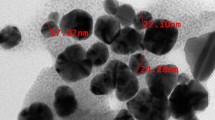Abstract
A novel method and instrumental system to determine the total protein concentration in a liquid sample is described. It uses a fiber optic total protein sensor (FOPS) based on the principles of fiber optic evanescent wave spectroscopy. The FOPS applies a dye-immobilized porous glass coating on a multi-mode optical fiber. The evanescent waves at the fiber optic core-cladding interface are used to monitor the protein-induced changes in the sensor element. The FOPS offers a single-step method for quantifying protein concentrations without destroying the sample. The response time and reusability of the FOPS are evaluated. This unique sensing method presents a sensitive and accurate platform for the quantification of protein.
Similar content being viewed by others
References
Atherton BA, Cunningham EL, Splittgerber AG (1996) A mathematical model for the description of the Coomassie Brilliant Blue protein assay. Anal. Biochem. 233: 160–168.
Ausubel FA (1991) The conventional Coomassie Blue/acetic acid/methanol destaining procedure. Current Protocols in Molecular Biology. New York: Unit 10.6, Wiley-Interscience.
Bradford MM (1976) A rapid and sensitive method for the quantitation of microgram quantities of protein utilizing the principle of protein-dye binding. Anal. Biochem. 72: 248–254.
Brinker CJ, Scherer GW (1990) Sol Gel Science: The Physics and Chemistry of Sol-Gel Processing. New York: Academic press.
Cunningham AJ (1998) Introduction to Bioanalytical Sensors. John Wiley and Sons Inc. pp. 265–290.
Gupta BD, Sharma DK (1997) Evanescent wave absorption based fiber optic pH sensor prepared by dye doped sol-gel immobilization technique. Opt. Commun. 140: 32–35.
Johnson JA, Lott HA (1978) Standardization of the Coomassie Brilliant Blue method for cerebrospinal fluid proteins. Clin. Chem. 24: 1931–1933.
Lowry OH, Rosebrough NJ, Farr AL, Randall RJ (1951) Protein measurement with the folin phenol reagent. J. Biol. Chem. 193: 265–275.
Rabinovich EM (1994) Sol Gel Processing – General Principles. In Sol Gel Optics: Processing and Applications. Massachusetts, USA: Kluwer Academic Publishers.
Ruddy V (1990) An effective attenuation coefficient for evanescent wave spectroscopy using multimode fiber. Fiber Integrated Opt. 9: 142–150.
Sapan CV, Lundblad RL, Price NC (1999) Colorimetric protein assay techniques. Biotechnol. Appl. Biochem. 29: 99–108.
Sedmark JJ, Grossberger G, Hoffman E (1972) A rapid, sensitive, and versatile assay for protein using Coomassie Brilliant Blue G250. Anal. Biochem. 79: 544–552.
Tal M, Silberstein A, Nasser E (1985) Why does Coomassie Brilliant Blue interact differently with different proteins? A partial answer. J. Biol. Chem. 260: 9976–9980.
Zor T, Selinger Z (1996) Linearization of the Bradford protein assays increases its sensitivity: theoretical and experimental studies. Anal. Biochem. 236: 302–308.
Author information
Authors and Affiliations
Corresponding author
Rights and permissions
About this article
Cite this article
Preejith, P., Lim, C., Kishen, A. et al. Total protein measurement using a fiber-optic evanescent wave-based biosensor. Biotechnology Letters 25, 105–110 (2003). https://doi.org/10.1023/A:1021955032291
Issue Date:
DOI: https://doi.org/10.1023/A:1021955032291



